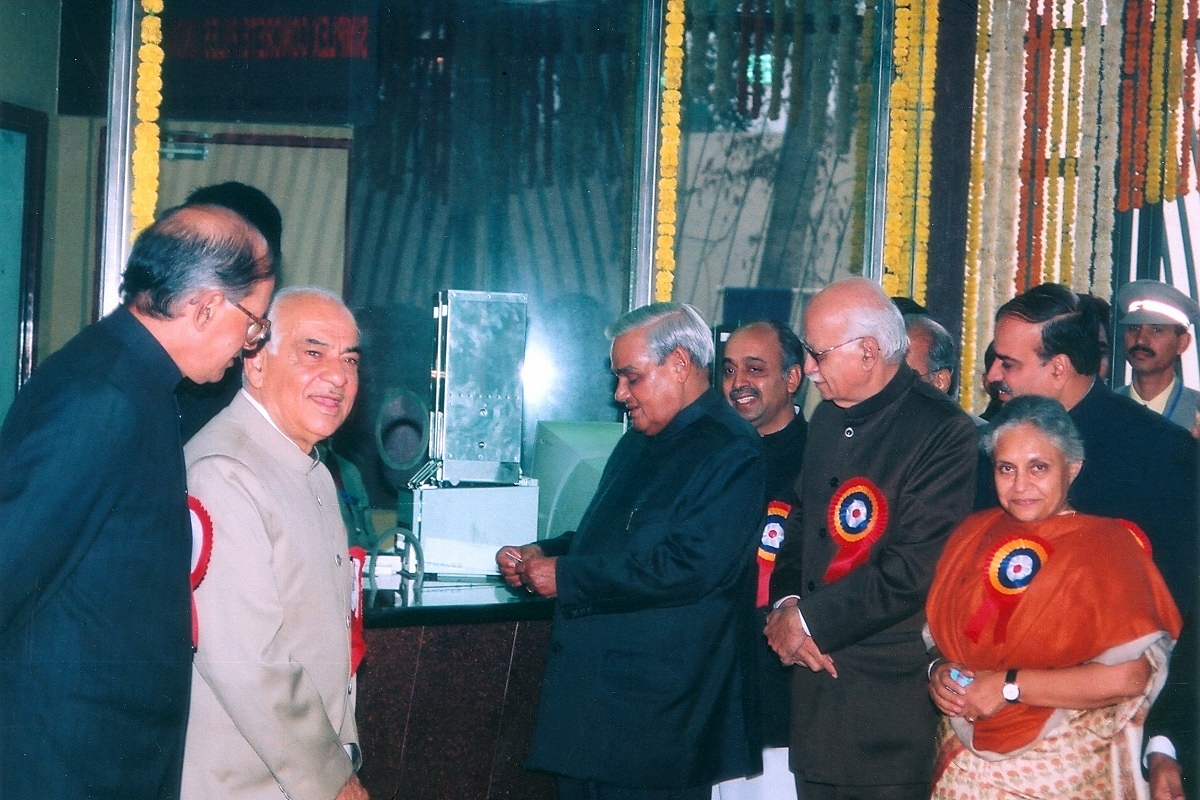Infrastructure
Inaugurated By PM Atal Bihari Vajpayee In 2002, Delhi Metro Grows From 8.2 Km To 391 Km
- Late PM Atal Bihari Vajpayee recognized the importance of building infrastructure and implemented various projects including the first phase of Delhi metro during his tenure.
- He inaugurated Delhi Metro’s first stretch, spanning 8.2 kilometres from Shahdara to Tis Hazari, on 24 December 2002.
- From its humble beginning in December 2002 with just 8.2 km stretch, the Delhi Metro has grown into a network of over 390 km in 2022.

PM Vajpayee along with LK Advani buying the metro ticket after inaugurating first stretch of Delhi Metro in December 2002 (DMRC)
Today (25 December) marks the 98th birth anniversary of India's 10th prime minister late Atal Bihari Vajpayee.
Elected as prime minister thrice between 1996 and 1999, Vajpayee was the only non-Congress prime minister to complete the full term of five years. At the end of his term in 2004, India's gross domestic product growth was inching towards double digits and inflation was under control.
One of the greatest contributions of PM Vajpayee was his government’s infrastructure push across the nation.
From building humble rural roads as part of Prime Minister Grameen Sadak Yojana (PMGSY) to constructing world-class highways crisscrossing India under the Golden Quadrilateral project, PM Vajpayee recognized the importance of building infrastructure and implemented various projects including the first phase of Delhi metro during his tenure.
Delhi Metro: India’s largest
Delhi Metro had begun its commercial operations on 25 December, 2002, a day after then prime minister Atal Bihari Vajpayee had inaugurated DMRC’s first stretch, spanning 8.2 kilometres from Shahdara to Tis Hazari, with just six stations.
From its beginning in December 2002 with a corridor of just 8.2 km spanning six stations on the Red Line, the Delhi Metro has grown into a network of over 390 km in 2022, completing an eventful journey of 20 years of operations.
The Delhi Metro Rail Corporation (DMRC) today operates multiple corridors in the national capital and neighbouring cities.
The DMRC network’s current span is nearly 391 km with 286 stations (including the Noida–Greater Noida Metro Corridor and Rapid Metro, Gurugram).
The network has now crossed the boundaries of Delhi to reach Noida and Ghaziabad in Uttar Pradesh, Gurgaon, Faridabad, Bahadurgarh and Ballabgarh in Haryana.
The Delhi Metro has also contributed tremendously on the environment front by becoming the first ever railway project in the world to claim carbon credits for regenerative braking.
DMRC has also been certified by the United Nations (UN) as the first Metro Rail and Rail based system in the world to get Carbon Credits for reducing GreenHouse gas emissions as it has helped to reduce pollution levels in the city by 6.3 lakh tons every year.
To mark the two decades of operations, Delhi Metro on Saturday (24 December) ran a special train that was flagged off by Vajpayee.
A special exhibition, ‘Tracing Delhi Metro’s Journey’, commemorating 20 years of operations was also opened on Saturday.
A day after the inauguration of the first-ever corridor in 2002, the rush was so “massive” that authorities had to issue “paper tickets” to handle the flow of passengers, officials had told PTI earlier.
The introduction of the state-of-the-art rapid transit system was such a novel mode of transport in the city that many people believed it was only there temporarily and thus the DMRC had to issue advertisements in newspapers to tell people that it was “here to stay”, they had said.
DMRC trains, on average, run 400-600 km and 16-18 hours a day, officials said.
Rare images of the very first piling work done in the national capital for building Delhi Metro and old newspaper clippings are among the archival documents which have been put up on display as part of a permanent exhibition at Kashmere Gate station of the network last December by the DMRC.
(With inputs from PTI)
Support Swarajya's 50 Ground Reports Project & Sponsor A Story
Every general election Swarajya does a 50 ground reports project.
Aimed only at serious readers and those who appreciate the nuances of political undercurrents, the project provides a sense of India's electoral landscape. As you know, these reports are produced after considerable investment of travel, time and effort on the ground.
This time too we've kicked off the project in style and have covered over 30 constituencies already. If you're someone who appreciates such work and have enjoyed our coverage please consider sponsoring a ground report for just Rs 2999 to Rs 19,999 - it goes a long way in helping us produce more quality reportage.
You can also back this project by becoming a subscriber for as little as Rs 999 - so do click on this links and choose a plan that suits you and back us.
Click below to contribute.
Latest